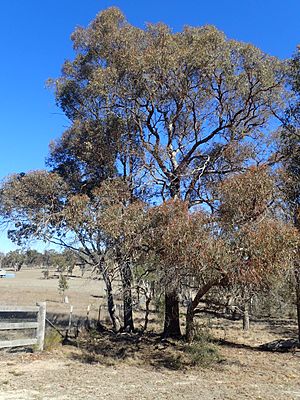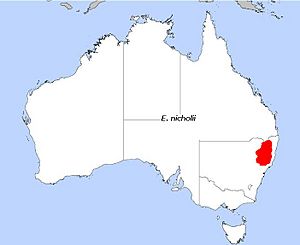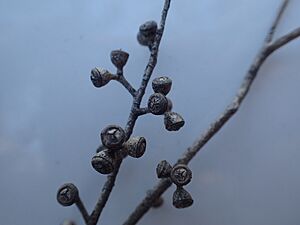Narrow-leaved black peppermint facts for kids
Quick facts for kids Narrow-leaved black peppermint |
|
|---|---|
 |
|
| Eucalyptus nicholii, east of Armidale | |
| Conservation status | |
| Scientific classification | |
| Genus: |
Eucalyptus
|
| Species: |
nicholii
|
 |
|
| E. nicholii , field distribution | |
| Synonyms | |
|
|
The Narrow-leaved black peppermint, also known as the willow peppermint, is a special type of Eucalyptus tree. Its scientific name is Eucalyptus nicholii. This tree only grows naturally in New South Wales, Australia.
It is a small to medium-sized tree. It has thick, rough bark on its trunk and branches. Its adult leaves are small and narrow. The tree produces white flowers from buds that grow in groups of seven. After flowering, it forms small, round or cone-shaped fruits.
Contents
About the Narrow-leaved Black Peppermint
Eucalyptus nicholii is a tree that usually grows to be about 15 to 18 meters tall. That's like a five-story building! It has a special woody swelling at its base called a lignotuber. This helps the tree regrow if it gets damaged, for example, by fire.
Bark and Leaves
The tree's bark is thick, rough, and fibrous. It can be yellowish-brown to grey-brown, with reddish-brown layers underneath. The bark on the trunk and main branches is deeply cracked. However, the bark on the smaller, outer branches can be smooth and peels off in short strips.
Young plants and new shoots (called coppice regrowth) have dull, greyish leaves. These leaves are long and narrow, about 20 to 64 mm long and 2 to 10 mm wide. Adult leaves are also a dull greyish-green on both sides. They are narrow and spear-shaped, about 60 to 140 mm long and 5 to 12 mm wide. Each adult leaf has a stalk, called a petiole, which is about 5 to 15 mm long.
Flowers and Fruit
The flower buds grow in groups of seven in the leaf corners. Each group of buds sits on a small stalk, called a peduncle, which is 3 to 8 mm long. Each individual bud also has its own tiny stalk, called a pedicel, about 2 to 4 mm long.
When the buds are ready to open, they are oval-shaped, about 3 to 5 mm long and 2 to 3 mm wide. They have a cone-shaped cap, called an operculum, which covers the flower parts. The tree flowers from late summer to early autumn, and its flowers are white.
After the flowers bloom, they turn into a woody fruit. This fruit is a capsule that can be round, bell-shaped, or cone-shaped. It's about 3 to 4 mm long and 3 to 5 mm wide. The parts that release the seeds stick out a little bit from the edge of the fruit.
How it Got its Name
The Eucalyptus nicholii was first officially described in 1929. This was done by two important botanists, Joseph Maiden and William Blakely. They wrote about it in Maiden's book, A Critical Revision of the genus Eucalyptus.
The second part of its scientific name, nicholii, was chosen to honor Richard Nicol. He was Joseph Maiden's private secretary and the "Chief Clerk" at the Botanic Gardens.
Where the Tree Grows
The narrow-leaved black peppermint tree likes to grow in shallow, not very fertile soils. These soils are usually found over shale and slate rock. You can often find it in grassy areas or in woodlands with tough-leaved plants. It often grows alongside other eucalyptus trees like Eucalyptus andrewsii and Eucalyptus caliginosa.
This tree is only found in the Northern Tablelands region of New South Wales. It grows especially in the area between Walcha and Tenterfield, and to the east of these towns. While it's spread out, you'll find it most commonly in the middle parts of its range.
Protecting This Eucalyptus Tree
This eucalyptus tree is listed as "vulnerable" by the Australian Government. This means it needs special protection to make sure it doesn't disappear. The New South Wales Government also protects it under its Biodiversity Conservation Act 2016.
Most of these trees grow on private land or along roadsides. Not many are protected in national parks or nature reserves. The biggest dangers to this tree are:
- Land clearing: When land is cleared for farming or building.
- Habitat fragmentation: When its natural home is broken up into smaller pieces.
- Wrong fire management: Fires that are too frequent or not frequent enough.
- Grazing animals: Livestock and wild goats eating the young trees.
- Road work: Damage from maintaining roads.
- Collecting firewood: People cutting down trees for firewood.
There are fewer than 40 known places where this tree grows. Most of these places are not protected in national parks or state forests.
Why People Plant This Tree
This tree is very popular for planting in gardens and parks in southeastern Australia. People love it because its fine, dense leaves make it look very attractive.
See also
 In Spanish: Eucalyptus nicholii para niños
In Spanish: Eucalyptus nicholii para niños




